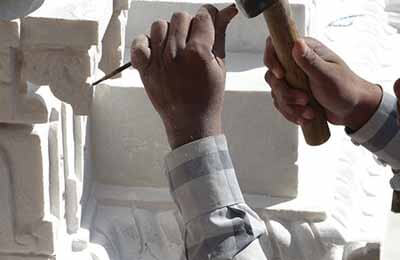雕刻一抹朱砂红
时间:2022-07-24 06:27:07

清代诗人袁枚曾用“阴花细缬珊瑚明,W霞隐隐东方生”来赞叹雕漆之美,乾隆皇帝则用“不见刀痕见画工”对雕漆工艺作出了高度的评价。雕漆器物是我们祖宗留下的最奢华的物质文化与精神财富之一,默默地向人们诉说着大唐的繁华、宋代的清雅、元代的浑厚、明清的细腻。
雕漆,又称“剔红”,主要工序为雕,主要原料为漆,制作过程是在厚厚的漆层上进行雕刻。为什么称之为“剔”而不是雕呢?著名收藏家马未都曾经有过解释:雕,是雕刻。雕刻在我们心目中是硬碰硬的概念,比如篆刻印章、雕刻石像,都是硬碰硬;硬碰软的时候才称之为剔。那么,当漆器的漆膜形成一定厚度,在半干的状态下,工匠用刀在上面轻轻剔出纹样,是硬碰软,所以叫剔,不叫雕。
雕漆制作历史长达数千年,不同时期的器物有着独特的鲜明特征。元代时,民间富贾大多以雕漆器作为婚嫁礼品,以剔红器为多,取“如胶似漆”之意,造型则以盘、盒等实用器为主。明代雕漆漆色更加丰富,在元代的基础上又出现了剔黄、剔彩器。造型比元代的增大增高,出现梅瓶、提匣、小柜、插屏等;崇尚纤巧华丽,繁缛细腻,刀法快利,锋棱外露,不重视磨工。清代雕漆以乾隆时期最多,范围几乎涉及宫廷生活的各个方面,小到文房用具、桌椅柜几,大到金銮宝座;雕刻技法上融合了元代浑朴圆润的特点和明代纤巧细腻的风格,形成了大气富贵的独特造诣。
一寸光阴一寸金
“我认识一位地产开发商,他看上一了块地,拆楼的时候他盯上了楼里一些没有被搬走的家具、工艺品,因为是识货人,此公最后发现这些楼里面的宝贝比这块地还值钱。这些宝贝里有相当一部分就是雕漆。”
讲完这个故事,杨之新笑言:“要说投资,北京雕漆太有增值空间了,这是很明显的事。”2007年,中国工艺美术大师文乾刚和陈厚棣创作了巨型雕漆盘《剔红九龙闹海盘》,这个大盘有1.9米高,以紫铜做胎,在文乾刚、陈厚棣两位大师主持下,耗费一年多时间制作而成。大盘的托架由红木制成,镂空雕刻的灵芝云龙纹,精细而繁复。2010年,一位台湾商人用40万元购买了这个雕漆大盘,现在,台湾商人有意出售,价位已涨到800万元。
与一般的工艺品相比,雕漆工艺品创作周期很长,工艺复杂,如明古斋的《山水人物卷缸》的漆厚竟然达到20毫米,也就是说至少要刷340遍漆。硬化剖磨也不可小觑,在大师眼中,这如同“二次创作”,是雕刻的再精化。硬化就要三四个月,再加上技师用砂纸细细打磨出漆的光泽温润又要花费100天的时间,总体工作最起码近一年。“做精品这是必须的”,杨之新说,“它就是一个时间的艺术品。”
除了费时,雕漆的工艺也让它区别于一般的工艺品,并带有天生的优越感。杨之新介绍,雕漆的每一道工艺都有专门的技术,设计、制胎、涂漆、描样、雕刻、磨光……复杂繁难,一个人很难全掌握,从古至今,都是分工做,有人一辈子在制胎,有人一辈子在雕刻,有人一辈子在作旧……就算领做的,也是一个年龄只做一种活,20岁涂漆,30岁刀活儿,40岁设计策划,可他只用几年时间就将这些活儿全学会了。与其他艺术一样,天分是最重要的因素。尤其是雕刻这一步除了熟练最考验的是制作者的悟性,他说:“就如同武术中的刀法一样,最高境界是心中有刀。”
雕漆有“一刀下去,不能悔刀”的说法,尤其是在创作人物时,要做到衣带飘飘已很不易,再做到喜怒哀乐呼之欲出就更困难了。活灵活现的雕漆人物背后,是杨之新付出的无数心血与努力。当年,为了将呆板的雕漆人物刻画出眉目传情的生动效果,杨之新临摹了大量古代绘画作品,并收集明清两代雕漆文物仔细研究。他还不辞幸劳到北京故宫、沈阳故宫、承德避暑山庄、山西云冈石窟、四川大足等名胜古迹写生。曾经一度,为锻炼对人物的造型能力,他每天下班后都赶到北京站,为形形的行人画人像素描直至半夜,再赶末班车回家。
天道酬勤,如今,杨之新以高超的设计水平,精湛的雕刻技法,达到了运刀如笔、得心应手的境界,特别是在表现人物的创作上,融入立体雕塑和象牙雕刻技法,把人物的体貌和个性表现得惟妙惟肖。
收藏市场方兴未艾
王强长期从事漆器的收藏和买卖。他介绍,目前漆器收藏市场呈现两种状况:一是漆器市场流通数量较少,精品更少;二是懂漆器的专业人士少。正因为如此,王强认为,漆器拍卖价格还有很大潜力可挖。2003年,他在国内以7万元人民币的价格拍出一个明朝嘉靖年间的花鸟盘,而完全相同的一个盘子,在2008年3月份纽约佳士得的春季拍卖会上竟拍到13万美元的高价。王强认为,不同于玉器和瓷器,漆器收藏在业界仍然属于冷门。国内市场与日本和欧美市场相比,对雕漆的认可度和重视程度还不足,拍卖价格潜力巨大。王强说:“要收藏漆艺作品其实很难,讲起古代漆器,我们自然会提到战国和汉朝漆器,但是你找得到吗?在拍卖场上更多的是明朝剔红漆器,但亦是价格不菲。能够在古玩市场上找到的也就是一些清末和民国的外销漆器。而当代漆器只有在漆艺家手中才买得到,几乎没有其他渠道。目前京城雕漆,大部分以中低档为主,只有五六个人在做精品,这些收藏级的精品就是我最为重视的。”
在雕漆生产最旺的上世纪50年代至80年代,我国每年出口漆器近万件,为国家创收大量外汇。那时的雕漆精品不论是成套家具、小套茶具或单件家具,都具有选题贴近时代、造型丰富及做工精细、用料考究的特点。这一时期的作品大都是老漆器师傅们的巅峰之作,但它们的收藏价值却被严重低估,其收藏与投资价值在未来会有一个明显的攀高过程。
“现在中国国力增强,人们对艺术品收藏越来越感兴趣,不仅外国消费者喜欢雕漆,一部分富裕起来的国人也开始喜欢雕漆制品,特别是剔红,富丽喜庆,符合中国人的审美。而且现在的雕漆大师不仅仅继承了传统艺术与品位,还开创了新的花样与设计,是一种有生命力的传统工艺品,投资前景十分巨大。”王强说。
雕漆艺术品除了收藏价值被低估外,雕漆收藏面临的另外一个瓶颈是,漆器的管理和保存难度很大。王强介绍,漆器不怕水,泡在水里面都没关系,但是怕干燥,容易裂且不好修补。现在都是用恒温、恒湿的条件保护,一般在温度在15~18摄氏度之间,湿度在55%左右最为适合。这样的保存条件也让一些投资者望而却步。“但掌握窍门,漆器保存也没有那么难。对于小件漆器来说,在太干燥的环境下,收藏者可以用保鲜膜将其包起来加以保存。”
雕漆五步鉴别法
古董鉴赏需要丰富的历史和专业知识,除了多读多看之外,更要不断“上手”――亲手去把玩,“上手”次数多了,自然形成独特的手感。鉴别雕漆真伪的主要方法有四种:
壹 看包浆,一件雕漆作旧的手法无论多么高明,漆皮入手的感觉绝对不同,真品即使保养再好,几百、上千年的空气氧化以及烟熏火燎依然会在表面留下一层包浆;而用草酸作出的包浆触手轻滑浮躁,放大镜下观察甚至能看到鲜艳的红漆。
贰 闻气味,就是用嗅觉的方法鉴别漆器。雕漆有一定的味道,这个大家都知道,要把这个味道去掉是需要一定时间的,好的雕漆有扑鼻的芳香,如果是新的或不是好的雕漆,我们用鼻子一闻就有一股怪味。
叁 看底胎,时下伪雕漆绝大部分使用聚酯乙烯之类的塑料为胎,这在古代是不可能的。
肆 看款识,事实上绝大部分雕漆都无款识,包括清宫造办处“油漆作”的真品。有款识的分两类:明代宣德年以前的在雕漆底部用针划出款识,这叫“针划款”;宣德之后采用刀刻楷书年号,然后填金,叫“填金款”。
伍 根据雕漆工艺的变迁、各朝雕漆特征判断,各时期的雕漆虽然在整体及结构上没有本质的区别,但是比较一下各个时期的雕漆,还是有一定区别的。以实物而论,宋元早期的雕漆,纹样都比较浅,也就是后人说的“用朱不厚”,大约10层左右;元末明初的风格是纹样加深;到了明清以后,剔得就比较深了。明清两朝至少髹漆36层,多者百层。如现藏于英国维多利亚埃尔伯特美术馆的一件乾隆御用龙纹宝座,髹漆厚实肥正,超过百层。明代和清代剔红的最大区别是打磨。明朝剔红完工后等髹漆彻底干透,要用野生锉草精心打磨出光泽,随着刀具的进步和审美品位的发展,清朝雕漆则一步到位,不再打磨,全靠刀工的圆润起转剔出花纹样式。从工艺角度上讲,纹饰逐渐加深就是加大制作难度,提高质量要求。
As the most luxurious heritage anded down by our ancestors, carved lacquerware bears he most prominent features of the different times in history―he prosperity of Tang, the refinement of Song, the simplity of Yuan, and the intricacy of Qing. Yuan Mei, a poet of the Qing dynastry marveled at the beauty of carved lacquer as “Inlaid with flowers bright as corals, painted with the red of a rising sun”, and Emperor Qianlong highly commended the craftsmanship saying “It is more a painting than it is a carving.”
Carved Lacquer, also known as “Digging Red”, is the carving of lacquer. According to modern collector, Ma Weidu, “carve” is to cut shapes out of solid surface, it is solid versus solid, such as the carving of a seal or sculpture; whereas “dig” is to cut shapes on soft surface. Lacquerware is carved when the lacquer is half dry, and artisans use knife to dig out patterns on the soft surface, so it is called “dig”, not “carve”.
The craftsmanship of carved lacquer originated over a thousand years ago. Carved lacquerware carrys the most prominent features of the respective times. In Yuan Dynasty, carved lacquerware, mainly carved red lacquer plates and boxes, was used as drowry as it symbolizes “sticking to each other like lacquer”. In the following Ming Dynastry, carved yellow and multi-color wares were developed. Bigger and taller, Ming Dynastry lacquerware, such as plum vase, portable case, locker, and screens, features luxurious and intricate design as well as sharp and unpolished carving. Qing Dynasty lacquerware was mostly produced during the years of Qianlong Emperor, covering everything aspect of court life, from stationary, to furniture, to the throne. Integrating the simple and smooth style of Yuan and the intricate and merticulous style of Ming, the craftsmanship in the Qing Dynasty features a unique stately and noble character.
Time is Money
“A real estate developer I know purchased a piece of land years before. When demolishing the building, he managed to retain some of the furniture and artcrafts left behind, which he later found, are more valuable than the piece of land. Many of the artcrafts are carved lacquerware.
With a smile, Yang Zhixin concluded, “If you want to invest, obviously Beijing carved lacquerware has great room for revaluation.” In 2007, two Chinese master artisans, Wen Qiangang and Chen Houdi, jointly created a carved lacquer plate “Nine Dragons Playing in The Sea”. Measuring 1.9 meters and made of red copper, the plate took more than one year to complete. Its mount is made of redwood, carved with intricate dragon and ganoderma pattern. In 2010, a Taiwan businessman bought it at 400,000 Yuan, and now he is willing to sell it but at 8 million Yuan.
Unlike other arts and crafts, carved lacquerware takes longer and more complicated techniques to create. The Landscape and Figure Jar of Ming Gu Zhai, for example, has a 20 millimeter lacquer, which requires 340 rounds of polishing. “Hardening polishing” is the second round of creation. It takes 3 to 4 months to harden, and over 100 days of polishing to get a smooth lacquer, which is at least a year in total. “It is necessary to the making of refined works”, said Yang Zhixin, “it is an artwork of time.”
In addition to time consuming, the techniques of carved lacquer is also unlike any other. According to Yang Zhixing, every process of carved lacquer, from design, mould, paint, sketch, sculpt to polish, requires special techniques. The process is so complicated that since ancient times carved lacquer has been a team work, with different people specializing in different processes. Even the lead inheritor of the trade would only do one job at a given age: painting at 20, carving at 30, and designing at 40. But Yang Zhixin mastered all the skills in just a few years. Like with other artforms, talent is the most important element for success, especially when it comes to carving. “Like swordplay in martial arts, the highest level is that the sword is in your heart before you play.”
“There is regret in carving”, especially when you create human figures. It is not easy to carve clothes, not to mention vivid expressions. Behind each carved character is years of devotion and efforts of Yang Zhixing. To breathe life into the carved figures, Yang Zhixin has imitated large amouts of ancient paintings and studied Ming and Qing Dynasty carved lacquerwares. His footprint had reached the Imperial Palace in Beijing and Shenyang, the Summer Palace in Chengde, Yungang Grottoes in Shanxi, and Dazhu Grottoes in Sichuan. For a time, he would go to the Beijing Railway Station to sketch various figures until the time of last bus. Years of efforts paid off. Today, Yang Zhixin could wield the carving knife as if writing with a pen. He is especially versed in carving vivid human figures with techniques from three dimensional carving or ivory carving.
A Growing Market
Wang Qiang has been collecting and dealing with carved lacquerware for a long time. He explained the two characteristics of the carved lacquerware market: very few lacquerware, even less high quality ones on the market; and very few professionals who understand lacquerware. But just because of these, he believes that there is huge potential. He also shared a story with us. In 2003, he acquired a Bird and Flower Plate of the Qing Dynasty on an auction with 70,000 Yuan, and in March 2008, an exact same plate was sold at 130,000 USD on the Christie Spring Auction. Unlike jade and porcelain, lacquerware collection is still a niche market. The awareness of and attention on carved lacquerware is lower than it is in Japan and western countries. There is much room for price rise in auctions.
According to Wang Qiang, “It is very difficult to collect carved lacquerware. We all know about carved lacquerware during the Warring States period and the Han Dynasty, but you cann’t find any. The most auctioned carved lacquerware are Ming Dynasty red lacquerware, usually at high prices. What you can find in the antique market is some Qing Dynasty and ROC exports. Comtemporary lacquerware can only be sourced from lacquer artists. In Beijing, most collectors are focusing on the lower end, with only 5 to 6 on refined works, which are what I am looking for.”
From the 1950s to 1980s, carved lacquerware were made in large quatity, over 10,000 a year, for export, and had generated huge foreign exchange gains for the country. The good ones at those times, be it furniture sets, tea sets, or single furniture, feature comtemporary themes, good materials, and intricate craftsmanship. They are the best works of the old generation experienced makers, but their value is greatly underevaluated, so there will be a upward trend of their value in the future.
“As the nation gets stronger, the Chinese’s interest in artwork collection is also increasing. Not only foreigners, but also a number of rich Chinese start to like lacquerwares, especially red ones, as the color signifies happiness in Chinese aethestics. The carved lacquerware artisans today are not only carrying on the traditional art and taste, but also innovating new patterns and designs. Carved lacquerware is a thriving traditional craft and has huge investment potential.”
Another bottleneck for carved lacquerware collection is the difficulty of storage and preservation. Lacquerware can survive water, even if immersed in water, but not draught, which will cause fissure. It is best preserved in constant temperature and humidity, usually at 15-18℃ and 55% humidity, which scares many investors away. “But if you know the tricks, preservation is not that difficult. For small lacquerware, if it is too dry, you can simply wrap it up with plastic wrap.”
The identification of antiques requires not only rich knowledge about history and the objects, but also “practice”. With enough practice, your hands will develop a special feeling. There are five ways to tell a authentic carved lacquerware from a fake.
1. Feel: Not matter how skillfully the fake is made, it doesn't feel the same as an authentic one. Authentic lacquerware, even well perserved, has an oxidated layer that is smooth and natural. The layer on a fake, made with oxalic acid, however, feels slippery and light. With a magnifier, you can even see through its red paint.
2. Ordor: or smell. Carved lacquer has an ordor, which takes time to disappear. Good lacquerware has a fragrant smell, whereas new or bad ones emit a strange ordor.
3. Material: Most fakes today are made of polyester, which could not exist in ancient times.
4. Inscription: Most carved lacquerware has no inscriptions, including anthentic lacquerwares designed by the Qing Dynasty Purchase Department. Only two categories of lacquerware are marked: lacquerware made before the rule of Xuande Emperor in Ming Dynastry, which is inscripted with needle at the bottom, called “needle scripted style”, and lacquerware made after the rule of Xuande Emperor, which has the year of the emperor carved in standard script and filled with gold, called “gold filled style.”
5. History and characteristics of carved lacquerware at different times: Although the structure of carved lacquerware remain unchanged over different dynasties in history, there is certain differences in patterns and techniques at different times in history. For example, the lacquer in the early Song and Yuan dynasties are shallow, only about 10 layers, and it grows over time, by the Ming and Qing dynasties, the lacquer is much deeper, ranging from 36 to 100 layers. The dragon pattern throne of Qianlong, which is now kept in the Victoria and Albert Gallery in the U.K., has a very thick layer of lacquer, polished at least 100 times.
